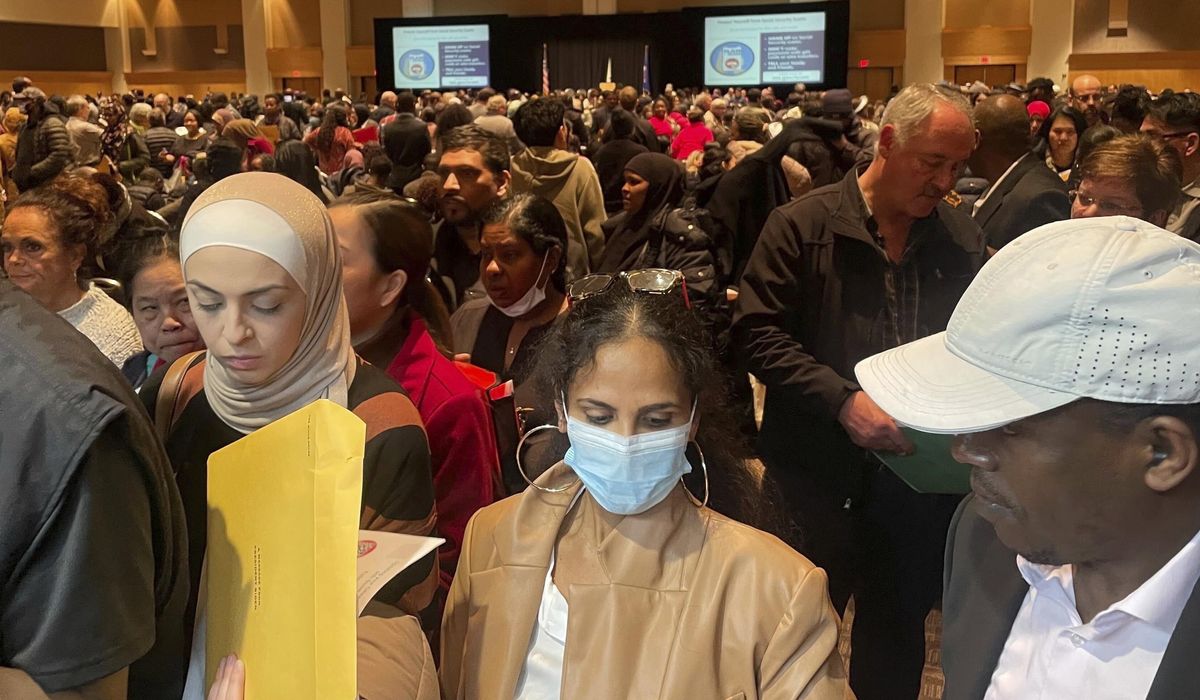


The Biden administration’s attempt to redesign the citizenship test has some immigration advocates arguing it will make it tougher for new arrivals to win citizenship.
U.S. Citizenship and Immigration Services is testing out a new English section, which requires applicants to be able to describe pictures, and a new multiple choice format for the civics questions. If all goes well, the agency wants to have the updates in place next year.
Activists say they expect immigrants to struggle with the new requirements.
“We have concerns that the proposed format and content of the test will impose new barriers to naturalization, particularly for those with lower English literacy skills and those not eligible for the English language exemption,” Helena Coric of the National Immigration Forum, a leading immigration advocacy group, told The Washington Times. “We have encouraged USCIS to treat the trial test as a research opportunity to evaluate test design and format and to be prepared to offer alternatives or forgo those changes if the trial format does not work well for these vulnerable populations.”
But Alfonso Aguilar, who led the 2008 redesign that produced the test’s current version, said the Biden administration is trying to water down the exam.
“It’s funny that progressive immigration advocates are complaining that the test may become harder when it’s pretty clear that these changes by the Biden administration are intended to make the test easier,” he said.
The goal of the test is to ensure applicants have a good grasp of America’s history and how its government operates, and that they also have a working knowledge of English.
Immigrants are given the questions to study ahead of time and must get six out of 10 correct to pass the knowledge section. They must also demonstrate English skills to their interviewer, unless they are exempt due to age or disability.
As with so much else about immigration, the test has become politicized.
The Trump administration tried to make changes, adding new questions to the study list and raising the bar to require 12 correct answers out of 20 questions asked.
The Biden team ditched that version and returned to the 2008 test Mr. Aguilar oversaw, then last year announced its own proposal for changes.
The proposed revision would formally test speaking by having an official ask the applicant to describe a series of photographs out loud.
Mr. Aguilar said he prefers the current test, in which the interviewer asks personal questions the immigrant previously answered in citizenship paperwork.
“The naturalization interview is the ideal setting to assess their English speaking skills. Effective two-way communication with a government official about matters of importance to oneself is essential to fully assimilate in America,” Mr. Aguilar said.
But the Rev. Alvan I. Amadi, a Catholic priest in Wisconsin who immigrated from his native Nigeria in 2009 and became a citizen in 2021, said describing images to a government representative could be more intimidating for immigrants like himself than discussing personal information.
“The proposed changes sound more difficult for test-takers, especially having test-takers describe images and pictures in their own words,” he told The Times. “The current test is challenging enough for immigrants, many of whom speak English as a second or third language.”
On the civics portion of the current test, applicants must answer six out of 10 open-ended questions correctly from a bank of 100 questions. The new multiple-choice test would give them a question with four possible answers and ask them to choose the right one, requiring the same grade to pass.
Applicants would take the multiple-choice test on a tablet rather than orally with an examiner, reducing the interaction that allows examiners to judge their English language skills.
Mr. Aguilar said immigration activists complained when the 2008 version was implemented, fearing it would be too hard.
But he said the passage rate increased because immigrants were eager to engage with the material for the test.
According to USCIS figures, the passage rate ticked up slightly to 91% after the 2008 version was implemented and rose again to 94% under the 2019 revision.
In 2021, the passage rate was 89.5% on the initial try, rising to 96.1% with the do-over each applicant is allowed.
There’s no clear reason for changing the test format since the Trump revisions “didn’t really make the test harder” and the passage rate has “always been high,” said Peter J. Spiro, an immigration law professor at Temple University who opposes the citizenship test requirement.
“In the end, I suspect, it will reduce to a different kind of exercise in memorization,” said Mr. Spiro, who studies citizenship. “Making public the pool of questions from which an examiner will select questions has always made the test more one of memorization than knowledge.”
USCIS, in an email to The Times, declined to provide materials from the new test and said it is still evaluating it.
“USCIS will continue to engage stakeholder partners, including community-based organizations with experience in naturalization, and the agency will thoroughly review trial-test results and their impact on reducing barriers to naturalization before considering any permanent revisions to the naturalization test,” the agency said.
• Sean Salai can be reached at ssalai@washingtontimes.com.
